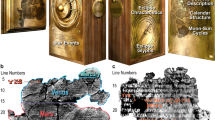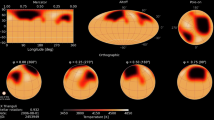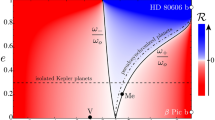Abstract
The Antikythera Mechanism is a unique Greek geared device, constructed around the end of the second century bc. It is known1,2,3,4,5,6,7,8,9 that it calculated and displayed celestial information, particularly cycles such as the phases of the moon and a luni-solar calendar. Calendars were important to ancient societies10 for timing agricultural activity and fixing religious festivals. Eclipses and planetary motions were often interpreted as omens, while the calm regularity of the astronomical cycles must have been philosophically attractive in an uncertain and violent world. Named after its place of discovery in 1901 in a Roman shipwreck, the Antikythera Mechanism is technically more complex than any known device for at least a millennium afterwards. Its specific functions have remained controversial11,12,13,14 because its gears and the inscriptions upon its faces are only fragmentary. Here we report surface imaging and high-resolution X-ray tomography of the surviving fragments, enabling us to reconstruct the gear function and double the number of deciphered inscriptions. The mechanism predicted lunar and solar eclipses on the basis of Babylonian arithmetic-progression cycles. The inscriptions support suggestions of mechanical display of planetary positions9,14,15, now lost. In the second century bc, Hipparchos developed a theory to explain the irregularities of the Moon’s motion across the sky caused by its elliptic orbit. We find a mechanical realization of this theory in the gearing of the mechanism, revealing an unexpected degree of technical sophistication for the period.
This is a preview of subscription content, access via your institution
Access options
Subscribe to this journal
Receive 51 print issues and online access
$199.00 per year
only $3.90 per issue
Buy this article
- Purchase on SpringerLink
- Instant access to full article PDF
Prices may be subject to local taxes which are calculated during checkout






Similar content being viewed by others
References
Price, D. de S. Gears from the Greeks: The Antikythera Mechanism — A calendar computer from ca. 80 BC. Trans Am. Phil. Soc. New Ser. 64, 1–70 (1974); reprinted by Science History Publications, New York. (1975)
Wright, M. T. Epicyclic gearing and the Antikythera Mechanism, Part I. Antiquar. Horol. 27, 270–279 (2003)
Wright, M. T., Bromley, A. G. & Magou, H. Simple X-ray tomography and the Antikythera Mechanism. PACT J. Eur. Study Group Phys. Chem. Biol. Math. Tech. Appl. Archaeol. 45, 531–543 (1995)
Wright, M. T. The Antikythera Mechanism: a New Gearing Scheme. Bull. Sci. Instrum. Soc. 85, 2–7 (2005)
Wright, M. T. Epicyclic gearing and the Antikythera Mechanism, Part II. Antiquar. Horol. 29, 51–63 (2005)
Wright, M. T. Counting months and years: The upper back dial of the Antikythera Mechanism. Bull. Sci. Instrum. Soc. 87, 8–13 (2005)
Wright, M. T. The Antikythera Mechanism and the early history of the moon-phase display. Antiquar. Horol. 29, 319–329 (2006)
Wright, M. T. in Proc. 2nd Int. Conf. on Ancient Greek Technology (ed. Tassios, Th.) 49–60 (Technical Chamber of Greece, Athens, 2006)
Wright, M. T. A planetarium display for the Antikythera Mechanism. Horol. J. 144(5), 169–173 (2002); erratum. 144, 193 (2002)
North, J. D. The Fontana History of Astronomy and Cosmology (Fontana, London, 1994)
Bromley, A. G. The Antikythera Mechanism. Horol. J. 132, 412–415 (1990)
Bromley, A. G. in Bassernet Vol. 2, No. 3 (Basser Department of Computer Science, Univ. Sydney, June, 1993)
Freeth, T. The Antikythera Mechanism: 1. Challenging the classic research. Mediterr. Archaeol. Archaeom. 2, 21–35 (2002)
Edmunds, M. & Morgan, P. The Antikythera Mechanism: still a mystery of Greek astronomy? Astron. Geophys. 41, 6.10–6.17 (2000)
Freeth, T. The Antikythera Mechanism: 2. Is it Posidonius’ orrery? Mediterr. Archaeol. Archaeom. 2, 45–58 (2002)
Illsley, J. S. History and Archaeology of the Ship—Lecture Notes. 〈http://cma.soton.ac.uk/HistShip/shlect36.htm〉 (1998)
Stephenson, F. R. Historical Eclipses and Earth’s Rotation (Cambridge Univ. Press, Cambridge, UK, 1997)
Steele, J. M. Observations and Predictions of Eclipse Times by Early Astronomers (Kluwer Academic, Dordrecht, 2000)
Steele, J. M. Eclipse prediction in Mesopotamia. Arch. Hist. Exact Sci. 54, 421–454 (2000)
Wright, M. T. The Scholar, the Mechanic and the Antikythera Mechanism. Bull. Sci. Instrum. Soc. 80, 4–11 (2003)
Espenak, F. NASA Eclipse Home Page. 〈http://sunearth.gsfc.nasa.gov/eclipse/eclipse.html〉 (2005)
Jones, A. The adaptation of Babylonian methods in Greek numerical astronomy. Isis 82, 440–453 (1991)
Britton, J. P. in Die Rolle der Astronomie in den Kulturen Mesopotamiens (ed. Galter, H. D.) 61–76 (rm-Druck & Vergansgesellschaft, Graz, 1993)
X-Tek Systems Ltd. 3-D computed tomography. 〈http://www.xtek.co.uk/ct/〉 (2006)
Malzbender, T. & Gelb, D. Polynomial texture mapping. 〈http://www.hpl.hp.com/research/ptm/〉 (2006)
Brooks, M. Tricks of the light. New Sci. 170, 38–49 (2001)
Chapman, A. Dividing the Circle (Wiley, Chichester, 1995)
Toomer, G. J. Ptolemy’s Almagest (transl. Toomer, G. J.) (Princeton Univ. Press, Princeton, New Jersey, 1998)
Acknowledgements
This work was financed by the Leverhulme Trust, the Walter Hudson Bequest, the University of Athens Research Committee and the Cultural Foundation of the National Bank of Greece. For essential support we thank the Ministry of Culture, Greece (P. Tatoulis), and the National Archaeological Museum of Athens (N. Kaltsas). We acknowledge help and advice from J. Ambers, J. Austin, G. Dermody, H. Forsyth, I. Freestone, P. Haycock, V. Horie, A. Jones, M. Jones, P. Kipouros, H. Kritzas, J. Lossl, G. Makris, A. Ray, C. Reinhart, A. Valassopoulos, R. Westgate, T. Whiteside, S. Wright and C. Xenikakis. Author Contributions T.F. carried out most of the CT analysis of structure and its interpretation. Y.B., A.T. and X.M. read, transcribed and translated the inscriptions. H.M and M.Z. catalogued the fragments, provided guidance on X-ray examination, and measured the fragments with J.H.S. R.H. led the team (D.B., A.R., M.A., A.C. and P.H.) that built and operated the Bladerunner CT machine, and provided CT reconstructions and advice. T.M., D.G. and W.A. built, operated and provided software for the PTM. M.G.E. was academic lead, and undertook the statistical analysis. T.F. and Y.B. organised the logistics of the experimental work, with inter-agency liaison by X.M. and J.H.S. The manuscript was written by T.F. and M.G.E. including material from Y.B., A.T., X.M., J.H.S., H.M. and M.Z. T.F. designed the illustrations.
Author information
Authors and Affiliations
Corresponding author
Ethics declarations
Competing interests
Reprints and permissions information is available at www.nature.com/reprints. The authors declare no competing financial interests.
Supplementary information
Supplementary notes
This file contains supplementary notes giving a key to fragment identification for Figure 1 of the main text and the dimensions of the fragments; further notes giving details of the script of the characters, their dating and the Greek text and its provisional translation from the Front Door inscriptions, the Back Door inscriptions and the Back Plate inscriptions near the Lower Back Dial. Also further notes giving a table to compare gear nomenclature and the gear tooth count estimates with previous estimates and to tabulate measured radii. Some notes are given on the individual gears and on the tooth count estimation procedure, including the effects of uncertainty in determining the centres of the gears. The gear train ratios are explained on the basis of simple Babylonian period relations. The equivalence of the epicyclic gearing and pin-and-slot mechanism to Hipparchos’ theory of the moon is proved. (PDF 1525 kb)
Rights and permissions
About this article
Cite this article
Freeth, T., Bitsakis, Y., Moussas, X. et al. Decoding the ancient Greek astronomical calculator known as the Antikythera Mechanism. Nature 444, 587–591 (2006). https://doi.org/10.1038/nature05357
Received:
Accepted:
Published:
Issue Date:
DOI: https://doi.org/10.1038/nature05357
This article is cited by
-
Usefulness of microfocus computed tomography in life science research: preliminary study using murine micro-hepatic tumor models
Surgery Today (2022)
-
A mechanical concentric solar model in Khāzinī’s Mu‘tabar zīj
Archive for History of Exact Sciences (2022)
-
A Model of the Cosmos in the ancient Greek Antikythera Mechanism
Scientific Reports (2021)
-
Mechanical computing
Nature (2021)



